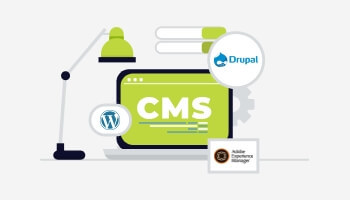Wondering which is the best CMS platform to use for your website?
A content management system or CMS is software that helps users create, manage, modify, and publish content on their websites and applications without any specialised technical expertise. It helps build a website without the need to write codes or get into the technical nitty gritty. For organisations, it’s basically a publishing engine that builds the foundation of content marketing.
For bigger organisations, given the massive scope of their work and a myriad of operations, having content management software is inevitable. Its features enable their marketing departments to engage prospective customers and drive revenue. So how do you choose a content management software that is right for your enterprise? Let’s find out!
Must-have features for your enterprise content management system


Enterprise content management isn’t a single technology or process. It’s an umbrella term that refers to creating, managing, preserving, and delivering content and information throughout its lifecycle. In an enterprise, this critical information is delivered to employees, business stakeholders and customers. A comprehensive enterprise content management system needs to tick the following pointers to be your ideal choice:
- Document Management
- Provides User Account Control
- Ensures Security
- Log Audit
- Facilitates Migration
- Is Scalable & SEO Friendly
The most popular content management systems


Various CMSs are available in the market, including Drupal, Adobe Experience Manager, WordPress, Joomla etc. Given its critical nature, enterprises need to choose the one that’s best suited for their needs. Let’s look at some of the most popular content management systems that are available in the market, along with their strengths and weaknesses.
-
Drupal
Drupal is an open-source CMS that was introduced in 2000 as a message board by its originator, Dries Buytaert. It’s used to build many websites and applications that are used every day. Drupal has great standard features, like easy content authoring, reliable performance, and excellent security. But what sets it apart from its competitors is the flexibility and customisation that it offers through innovation and state-of-the-art features. Its tools can be used to build versatile, structured content that’s essential for delivering dynamic web experiences.
Drupal is the driving force behind 2.1% of websites across the internet. It’s also the preferred choice of many premium and large-scale enterprises.
Strengths Weaknesses More choices of themes and plugins Getting used to it takes time Open source Significant updates are hard to implement Suitable for social networks Installation takes a little longer as compared to other CMS Flexible content elements creation -
Adobe Experience Manager
Adobe Experience Manager (AEM) is a comprehensive CMS that’s used for building websites, mobile apps, and forms. AEM facilitates the management of your marketing content and assets.
Strengths Weaknesses Can manage a lot of content Difficult to adopt without a tech background Gives access to Creative Cloud Integration Inconsistent user interface Incorporates an intelligent search approach Different sign-ins required to access other areas of the system Provides an individual workspace to manage uploaded projects Requires IT assistance throughout the lifespan of this product Has a variety of installation options Lack of flexibility in structure -
WordPress
WordPress was launched as a blogging platform in 2003 and has been a popular CMS worldwide since then. It’s a free and open-source CMS preferred by both individuals and organisations for website creation and development.
WordPress offers a wide range of third-party plugins that help in effective website management and content creation. It’s equipped with an interactive dashboard that facilitates seamless movement across the website. It doesn’t require coding or technical knowledge to build a website on WordPress.
Strengths Weaknesses Quick installation Vulnerable to cyber attacks Easy to use Performance is impacted by too many plugins Great options of themes and plugins Larger community base Open source
Now that you understand the pros and cons of each Content Management System, let’s dive into a comprehensive comparison between the three.
Drupal Vs. WordPress Vs. Adobe Experience Manager


| Parameter | Drupal | WordPress | Adobe Experience Manager |
|---|---|---|---|
| Market Share | 2.1% | 64.3% However, a larger part of it belongs to standalone blogs. Corporate website and E-commerce website share will be lower due to a lack of built-in enterprise content management solutions. | 1.6% |
| Ease of Content Management |
|
|
Very easy |
| SEO-friendly CMS | SEO features can be extended via Metatag module | SEO features can be extended via YoastSEO | Built-in support for SEO tags |
| Analytics and Tracking |
|
|
|
| CRM Integration SalesForce, HubSpot, Zoho |
|
|
|
| Ease of Theme Customisation |
|
|
|
| Document Management |
|
|
|
| User Access Control |
|
|
|
| Security |
|
|
|
| Log Audit |
|
|
|
| Ease of Migration and Updates |
|
|
|
| Availability of resources and community support. We can predict the availability of skilled resources considering the vacancies listed on Naukri.com for India. |
|
|
|
| Licence Cost | GNU GPLv2 Free | GNU GPLv2 Free | Starts at $100,000 |
| Server/Hosting Cost Cloud Server | ~ $60 – $500 per month | ~ $60 – $500 per month | Self-hosted |
| Design and Development Cost | Design and development cost for any website varies depending on the scope and complexity of the work involved in creative and technology services | ||
Also Read:
Final thoughts:
There are various aspects in which these leading Content Management Systems differ from each other. Considering your requirements, budget, and business goals is essential when choosing the one for your enterprise. No matter which CMS you choose, Amura Marketing Technologies has the expertise to integrate your preferred CMS and devise a winning marketing strategy for your organisation.
Being a leading performance marketing agency in India, Amura has helped many global brands transform their businesses digitally. Ready to give your organisation the digital edge? Get in touch with us today!
